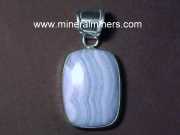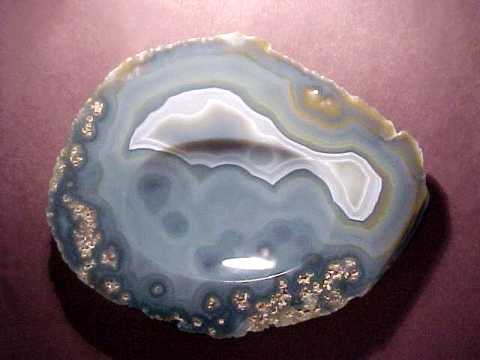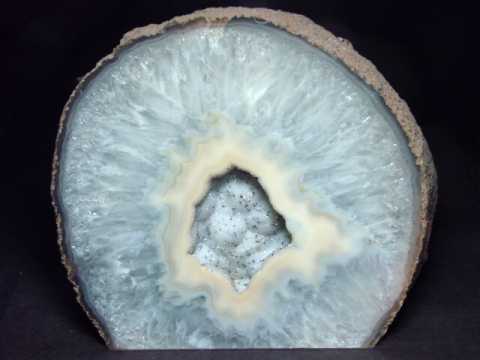


See our Agate Jewelry Designs
MINERALMINERS.COM® - Your Personal 'Link' Direct to the Agate Mines!TM
Agate Information
Agate is a variety of QUARTZ.
There are dozens of named quartz varieties.
See also our other Varieties of Quartz
Agate Information Topics
Agate Products For Sale in our Online Store
(Take any link to enter our Virtual Gallery)Return to the Index of
AGATE PHYSICAL PROPERTIES
- Agate Chemical composition: SiO2
- Class: tectosilicate
- Crystal system: Hexagonal-R; 32 (trigonal-trapezohedral)
- Crystal habit: usually as banded or layered botryoidal masses with microfibrous structure
- Zoning: color banding and layers of inclusions are common
- Specific gravity: 2.57-2.64
- Index of refraction: 1.53-1.55
- Birefringence: weak, 0.005 to 0.009
- Hardness: 6.5 to 7
- Color: frequently colored by impurities and then may be any color, most agate used for ornamental purposes is colored by artificial means.
- Luster: dull vitreous to greasy
- Transparency: translucent, can be transparent or opaque
- Cleavage: Cryptocrystalline quartz shows no cleavage, although parting may occur along layers and splintery fracture can develope parallel to microfibrous orientation.
- Fracture: conchoidal to splintery
- Streak: white
Return to the Index of


QUARTZ (Agate) BACKGROUND INFO
Agate is a cryptocrystalline variety of the mineral Quartz (SiO2). Quartz is the most abundant single mineral on earth. It makes up about 12% of the earth's crust, occurring in a wide variety of igneous, metamorphic and sedimentary rocks.
Quartz varieties are commonly separated into two groups based on the size of the individual grains or crystals; macrocrystalline quartz in which individual crystals are distinguishable with the naked eye, and cryptocrystalline quartz in which the individual crystals are too small to be easily distinguishable under the light microscope.
Some of the macrocrystalline quartz varieties are: Amethyst, Ametrine, Cat's-eye Quartz, Citrine, Phantom Quartz , Rock Crystal, Rose Quartz, Rutilated Quartz and Smoky Quartz.
Blue Aventurine Quartz and Green Aventurine Quartz are actually quartzites (a rock, not a mineral) composed essentially of interlocking macrocrystalline quartz grains with disseminated grains of other color imparting minerals.
The cryptocrystalline varieties of quartz may be separated into two types;
fibrous and microgranular. Chalcedony is the general term
applied to the fibrous cryptocrystalline varieties.
Agate is an example of a fibrous cryptocystalline
banded chalcedony variety of quartz. Carnelian, Chrysoprase and bloodstone
are other chalcedony varieties.
Chert is the general term applied to the granular cryptocrystalline
varieties of quartz, of which flint and Jasper are examples.
Return to the Index of
See all of our natural varieties of quartz:
Varieties of QUARTZ
Return to the Index of
AGATE OCCURRENCE AND DIAGNOSTIC FEATURES
Agate is a variety of chalcedony, which is the general term applied to fibrous cryptocrystalline quartz varieties. It is a mineral generally of secondary origin, forming in cavities and veins by deposition from meteoric groundwater containing gelatinous silica from the weathering of silicate minerals. It can also form by deposition from late hydrothermal solutions at or near the earth's surface under conditions of low temperature and low pressure. Agate is commonly associated with siliceous volcanics, occurring as vein or vesicle filling. It occurs as a petrifying agent in fossil wood and bone. Agate is frequently found lining or filling rock cavities and fissures, sometimes forming geodes.
Agate is characterized by its occurance, hardness, fracture, specific gravity, refractive index and luster.
Return to the Index of
AGATE HISTORY & USE INFORMATION
The name agate is from an old locality on the achate river in southwestern Sicily.
Some agate varieties have been named for specific colors such as carnelian for orange-red agate.
Agate varieties have also been named for patterns or inclusions present in the agate such as lace agate, fire agate, banded agate, and moss agate.
Agate has been used as gemstones and other ornamental objects for thousands of years.
In medieval times, the wearing of agate was said to bring
God's favor and make one agreeable and persuasive, giving victory and
strength to the wearer and protection from all dangers. Wearing agate was
also thought to give pleasant dreams and cure insomnia.
Early Greeks made amulets of agate for protection from the elements of the
sea.
Some of the earliest primitive stone tools (axes) fashioned by man's ancestors 2.5 million years ago in the Omo valley in Ethiopia, were made of quartz varieties such as agate. These materials were used because of their hardness and their isotropic brittleness which made it possible to shape the tools with relative ease.
The astrological sign of agate is gemini.
Agate is a birthstone for the month of May.
Agate is the symbolic gemstone for the 12th
wedding anniversary.
Return to the Index of


METAPHYSICAL AGATE PROPERTIES
Agate is said to enhance one's perceptiveness and to stimulate analytical capacity, and to provide balance between one's physical, emotional, intelectual and spiritual states. Agate is also said to alleviate hostilities and promote goodwill.
Agate is said to help treat disorders of the pancreas and to improve circulation.
For more in-depth metaphysical information, see our Metaphysical Books section.
Return to the Index of
Agate Items in our Virtual Gallery
© Copyright 1998-2020 Gem & Mineral Miners, Inc.® All Rights Reserved.

